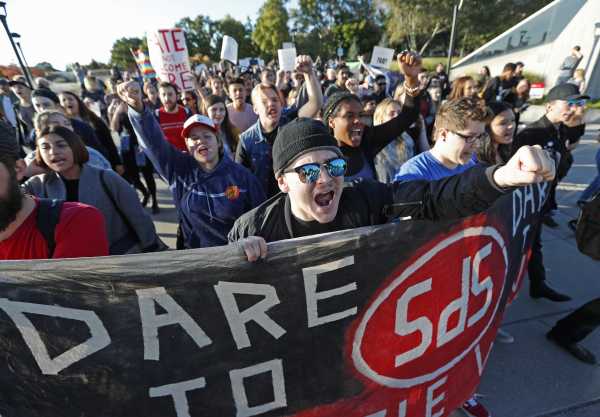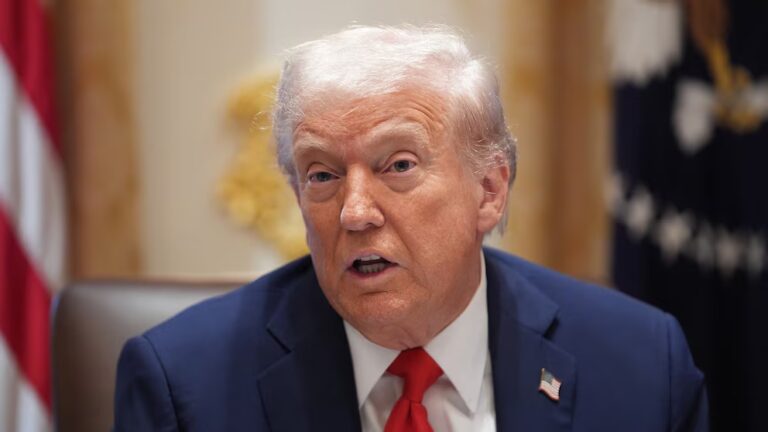
The status of free speech on college campuses is one of the most heated controversies in American public life today — and, in my view, somewhat overblown. In a couple of recent essays, my colleague Matt Yglesias and I surveyed the research on the topic and found little support for the claim that free speech rights are seriously imperiled at American universities.
In my piece, published earlier this month, I examined three data sources that I argued supported the view that incidents of speech by students or professors being suppressed are relatively rare. When they do happen, these incidents often target liberals and leftists, despite the breathless media coverage of conservative speakers being run off campuses. Yglesias looked at polling on student attitudes toward free speech and found little evidence that they were particularly hostile to free expression.
Musa al-Gharbi, the director of communications for an organization called Heterodox Academy, which promotes “viewpoint diversity on college campuses,” takes issue with both of our pieces. In a piece titled “Vox’s Consistent Errors on Free Speech, Explained,” al-Gharbi argues that we misuse data to paint a misleadingly rosy picture of speech on campus.
“Beauchamp and Yglesias’ essays don’t provide meaningful evidence (let alone knock down proof) that there is no free speech crisis at universities,” he writes. Of my essay in particular, he claims that “two studies were mentioned in the piece, [and] neither had their conclusions accurately represented.”
These are big charges — and they are not supported by al-Gharbi’s piece. I’ll let Matt speak for himself, but al-Gharbi’s claim that I misrepresented data in a way that indicates ideological “bias” does not stand up to scrutiny.
A review of my essay and the underlying research — including conversations with the authors of the two studies in question — affirm the thesis of my piece: that incidents of conservative speech being suppressed on campus are rare and do not add up to a national crisis.
What the core issues at stake are
Let’s start by recapping the central thrust of my argument. Here’s what I wrote:
In my piece, I summarized the findings of three studies (not two, as al-Gharbi claims):
All of these data sources seem to tell the same story: There are several dozen incidents of speech being suppressed on college campuses per year, and those incidents hardly target conservatives exclusively (more on that below).
Given that there are 4,583 colleges and universities in the United States (the bulk of which are four-year institutions), dozens of incidents is … not a lot. When you limit it to just conservative targets, the number becomes even smaller. Now, some might consider a few dozen incidents a year in a country of 4,583 higher education institutions a national crisis; I would consider it perhaps unfortunate, but not a crisis.
Al-Gharbi has concerns with the way I presented the data from the first two sources, which I’ll address in detail in the next sections. But he entirely omits the third — literally writing that my piece “drew from two sources” — and chides me for not citing it. Here’s al-Gharbi:
And here’s my original piece:
To be sure, FIRE thinks this is cause for alarm. But I see 42 disinvitations in 2016 — and really 31, if you take out Milo — out of the thousands of invitations higher ed institutions extend per year, and I can’t say that rises to the level of a crisis. (Al-Gharbi also mentions a quote from FIRE’s president that the organization receives more than 1,000 requests for assistance from people on campus per year, but the requests are not public, and it’s hard to tell what percentage of those would qualify as genuine threats to free speech.)
Now let’s look at the second source al-Gharbi recommends: a PEN America report from October 2016. PEN doesn’t actually attempt a quantification of free speech incidents on campus, instead preferring to categorize types of free speech crises and discuss particular incidents in depth.
The authors warn that campus free speech is “not free from threats” and “must be vigilantly guarded” — but they also conclude that the examples that have been uncovered so far do not represent a serious crisis.
“Free speech is alive and well on campus,” the PEN report states. “While current campus controversies merit attention and there have been some troubling instances of speech curtailed, these do not represent a pervasive ‘crisis’ for free speech on campus.”
In short? Based on these four studies — two of which are from sources al-Gharbi himself recommends — there is limited evidence of a systematic and serious threat to free speech on campus.
Al-Gharbi alleges significant errors in interpreting the Georgetown data — but a closer look says otherwise
Al-Gharbi claims that my treatment of FSP director Sanford Ungar’s data analysis was badly flawed and based on “a fundamental misunderstanding” of the data. First off, he claims, I failed to understand what Ungar was up to in his piece: “Dr. Ungar selected a sample of about 90 incidents from his full dataset (137 incidents).”
This is incorrect. Ungar did not “select a sample” of his data to analyze. He conducted his analysis in March, back when the total number of incidents was “more than 90,” on or off campus, in the FSP “Free Speech Tracker” database — and that’s the number I cited (correctly) in my piece. FSP’s research has progressed since Ungar’s piece — as of August 29, there are now 145 incidents, up from the 137 when al-Gharbi went to press — but that doesn’t mean I misread Ungar’s analysis in the way al-Gharbi suggests.
Al-Gharbi continues: “It would seem absurd to infer anything about how common free speech incidents are overall on the basis of Dr. Ungar’s preliminary data.” He suggests that Ungar would see this as a torturing of the data:
I agree that the FSP data on its own is not conclusive. I explicitly say this in the piece: “Ungar notes that his data is preliminary and not necessarily a full or representative sample. So we can’t put too much weight on the Georgetown findings.”
What I did argue in my article is that the FSP data is “consistent with what other academics and free speech watchdogs have found when they looked into the issue,” citing the two other studies I mentioned above.
Perhaps the most damning of al-Gharbi’s charges, at least as it relates to my treatment of the FSP study, is this:
To find out if my piece reached “basically the opposite” conclusion from the study I was reporting on, I called Ungar himself.
I asked him explicitly whether I was wrong to use his data set as a piece of evidence in my argument about the overall prevalence of free speech — whether he agrees with al-Gharbi that comparing the incidents in the tracker to the raw number of schools in the country is an abuse of his database.
“I’m not sure I would say you were wrong. I was, of course, delighted to see your piece,” Ungar said. “There are a lot of universities.”
Ungar has a nuanced view of the free speech situation on campuses. He is certainly not as much of a skeptic about the free speech “crisis” as I am — he believes that there is a real problem, particularly for university administrators who are terrified of a high-profile incident happening at their campus, and that there is “evidence” that speech is “being suppressed” in certain instances.
This is something I don’t deny in my article. As I wrote: “That’s not to say that there aren’t disturbing incidents on campuses. Robby Soave, an editor at the libertarian magazine Reason (and a good personal friend of mine), has unearthed some troubling examples of students and faculty tossing free speech ideals to the side.”
At the same time, though, Ungar does agree that the panic over the situation is being overblown — particularly as it relates to the speech rights of faculty and students, the subject of my piece.
“I don’t think we should be out there tearing our garments and wringing our hands,” he told me. “Overall, in my personal experience … I do not think that the ability of faculty and students to speak their mind is seriously compromised.”
In short: al-Gharbi falsely accused of me of misusing the Georgetown data and wrongly suggested that the conclusion I drew from the Georgetown data (in conjunction with the other studies cited) was the opposite of the author’s.
How imperiled are conservative professors, really?
Now let’s talk about al-Gharbi’s critique of my use of the Sachs data, relating to ideological dismissals of faculty members. He takes issue with this line from my original piece: “left-wing professors were more likely to be dismissed for their speech than conservative ones.”
He points out, correctly, that this phrasing is misleading — because there are more liberal professors than conservatives, the fact that liberal professors are more frequently fired for their views doesn’t mean any individual liberal professor is more likely to be fired than a conservative one. Sachs made a similar point in his original Niskanen piece, and it’s my fault for not being more precise in my original phrasing. I’ve updated my piece accordingly.
But al-Gharbi goes further than pointing out poor phrasing, claiming that Sachs’s data actually shows “the opposite” of what I suggested:
I was curious what Sachs thought of this, so I called him up. He did not agree with al-Gharbi’s interpretation.
“It really strains the data set to look at those numbers and to walk away with the idea that, even accounting for the differences in base populations, conservatives are somehow more put on than liberals,” he told me. “I think [al-Gharbi] might be putting greater weight on the number of conservative terminations than those numbers can really bear.”
The problem, he explains, is that there are so few firings of conservatives — just six in 2017, the year al-Gharbi analyzed — that it’s very difficult to make generalizations about conservatives being dismissed at a higher rate across the board. It’s just such a rare event that we can’t really come to conclusions about its probability.
“Even when you consider the fact that there are far fewer conservative faculty in America then there are liberals, we’re still talking about six terminations,” he explains. “I think any person should look at those numbers — 26 or 27 total in 2017 — and come away somewhat reassured that we’re talking about very, very [low] numbers in general.”
Which was, of course, the same point I was making in my piece. In context, I was not arguing that individual liberal professors are at greater risk than their conservative peers, but that other data sets are “strikingly consistent” with the FSP numbers in both the low overall numbers of professors targeted and the fact that a significant proportion of the targeted professors are liberal.
Let me be clear on this: I was not arguing, and do not believe, that liberal speech is more imperiled than conservative speech on college campuses. Rather, my aim in citing Sachs’s data was to show that there is no epidemic of repression of conservative speech on college campuses — that liberal speech is repressed too, and that the absolute rate of incidents of speech suppression is so low that the issue can’t be considered a major crisis.
For his part, Sachs sticks by the conclusion of his original piece, which is at odds with al-Gharbi’s contention. “I do stand by the claim that there is no campus free speech crisis,” he told me.
Heterodox Academy, and why this debate matters at all
In his piece, al-Gharbi takes aim at not just me but Vox more broadly. He writes:
For this claim, he offers all of two pieces of evidence: my piece and Yglesias’s. Setting aside the baseless claim of bias, al-Gharbi’s take is certainly a strong conclusion to draw from a sample of two.
Al-Gharbi also takes issue with how I referred to Heterodox Academy in my piece. I wrote that “entire books and online magazines are premised on the idea that political correctness is sweeping the American university,” with a link to Heterodox Academy’s homepage on the phrase “online magazine.” This bothered al-Gharbi very much.
“We’re not an online magazine,” he writes. “We’re an academic consortium of more than 2k faculty, grad students and (now) university administrators committed to increasing viewpoint diversity, mutual understanding and constructive disagreement in institutions of higher learning.”
Fair enough. That said, if you go to Heterodox Academy’s About page, the first thing it says is “Heterodox Academy began as a blog in late 2015.” It still maintains that blog, and puts significant emphasis on publication as part of its mission — as al-Gharbi, who was until recently “managing editor” of Heterodox Academy, well knows. I could have used a better term than “online magazine,” but spinning an unnamed reference to the site’s history as a major error seems overheated.
More importantly, al-Gharbi objects to my claim that Heterodox Academy was “premised” on the idea that political correctness is a major problem. “We are not ‘premised’ on fighting political correctness,” he writes. “Frankly, ‘political correctness’ is not even a big focus of our institution. So far in 2018 we’ve run one essay on the topic.”
This is a bit of a dodge. Sure, the phrase “political correctness” isn’t all that commonly used in Heterodox Academy pieces, but a fair reading of the group’s concerns would identify political correctness and the imposition of left-wing orthodoxy on campuses as an overriding concern for Heterodox Academy.
Don’t take my word for it. Here’s the very first post on Heterodox Academy, from its founder and NYU psychologist Jonathan Haidt, defining the then-blog’s founding premise:
And here is a passage from Heterodox Academy’s current website. It comes from a page titled “The Problem,” and defines what the organization is trying to work against:
And here’s a definition of the reason for Heterodox Academy’s founding from a July post on its blog, written by someone who recently attended its conference:
In the group’s own terms, then, the problem is that American campuses have become a “left-leaning tribal moral community” that suffer from a form of “orthodoxy” — wherein conservative voices are marginalized and shunned — due to a lack of “viewpoint diversity,” meaning a dearth of conservative faculty members on campus. I’ll let the reader decide if my use of the phrase “political correctness” to describe this concern was unreasonable.
So why does this all matter? It matters because claims of a campus free speech crisis (al-Gharbi’s piece included) unintentionally bolster a right-wing narrative that the campus is a haven of out-of-control liberalism — and that something dramatic needs to be done to address that.
In a vacuum, the notion of promoting “viewpoint diversity” is laudable. But we aren’t operating in a vacuum: We’re operating in a world where Republican legislators are using allegations of a campus free speech crisis and liberal bias among the academy to further efforts to crack down on individual freedom. As I wrote in the original piece:
I would assume Heterodox Academy’s core staff are too principled to support such measures. But by working to promote the idea that liberal bias and, yes, political correctness is a crisis, they provide ammunition to supporters of such efforts.
It’s especially bad to do so when the data doesn’t support the calls to panic. My initial piece cited three data sources that pointed in the same direction: The free speech crisis is overblown. Al-Gharbi claimed that I misrepresented two of those studies (and ignored the third) to the point that I reached “the opposite” conclusion as their authors — but this is false, and the authors of those studies agree. Indeed, it is al-Gharbi’s own reading and conclusions from the studies that turned out to be flawed.
Now, it’s possible that al-Gharbi is right, and that the free speech problem on campus “is likely worse than the available data suggest.” But the data is all we have, and the burden of proof should be on the people alleging a crisis — particularly in this political climate. Right now, I’m sticking with what the numbers are telling me.
Sourse: vox.com






